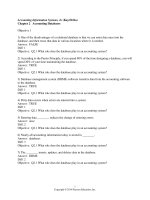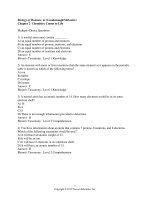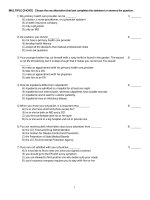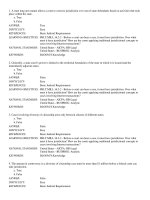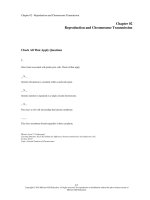The geography of north america environment culture economy 2nd edition hardwick test bank
Bạn đang xem bản rút gọn của tài liệu. Xem và tải ngay bản đầy đủ của tài liệu tại đây (40.96 KB, 15 trang )
The Geography of North America, 2e (Hardwick)
Chapter 2 North America's Environmental Setting
1) The study of the environmental characteristics of Earth is called what?
A) Human geography
B) Physical geography
C) Earth studies
D) Environmental geography
Answer: B
Diff: 1
Chapter Section: Introduction
Bloom's Taxonomy: 1 Knowledge - Select
GeoStandard1: 3. How to analyze the spatial organization of people, places, and environments
on Earth's surface.
GeoStandard2: 7. The physical processes that shape the patterns of Earth's surface.
2) Which major physical feature in North America was created by down-cutting?
A) The Appalachian mountains
B) The Erie Canal
C) The Great Lakes
D) The Grand Canyon
Answer: D
Diff: 3
Chapter Section: Landforms, Hydrology, Soils
Bloom's Taxonomy: 2 Comprehension - Select
GeoStandard1: 7. The physical processes that shape the patterns of Earth's surface.
GeoStandard2: 8. The characteristics and spatial distribution of ecosystems on Earth's surface.
3) Which major physical feature in North America did glaciers create?
A) The Rocky mountains
B) The Erie Canal
C) The Great Lakes
D) The Grand Canyon
Answer: C
Diff: 3
Chapter Section: Landforms, Hydrology, Soils
Bloom's Taxonomy: 2 Comprehension - Select
GeoStandard1: 7. The physical processes that shape the patterns of Earth's surface.
GeoStandard2: 8. The characteristics and spatial distribution of ecosystems on Earth's surface.
1
Copyright © 2013 Pearson Education, Inc.
4) The first mountain chain that slowed the western movement of early American settlers was
________.
A) The Rocky Mountains
B) The Appalachian Mountains
C) The Ozark Mountains
D) The Sierras
Answer: B
Diff: 2
Chapter Section: Landforms, Hydrology, Soils
Bloom's Taxonomy: 3 Application - Relate
GeoStandard1: 2. How to use mental maps to organize information about people, places, and
environments.
GeoStandard2: 15. How physical systems affect human systems.
5) The Fall Line is an imaginary line formed by points
A) Along eastern rivers that was the limit of accessibility for ocean going ships
B) At which draft animals of settlers moving west would drop from exhaustion
C) Along eastern rivers where there were waterfalls
D) All of the above
E) Both A and C
Answer: E
Diff: 2
Chapter Section: Landforms, Hydrology, Soils
Bloom's Taxonomy: 1 Knowledge - Select
GeoStandard1: 15. How physical systems affect human systems.
GeoStandard2: 8. The characteristics and spatial distribution of ecosystems on Earth's surface.
6) Mount Mitchell, the highest mountain in the Appalachians is ________ the highest peaks in
the Rocky Mountains and Sierra Nevada.
A) Much higher than
B) Much lower than
C) About the same elevation as
D) Almost as high as
Answer: B
Diff: 3
Chapter Section: Landforms, Hydrology, Soils
Bloom's Taxonomy: 3 Application - Compare
GeoStandard1: 4. The physical and human characteristics of places.
GeoStandard2: 7. The physical processes that shape the patterns of Earth's surface.
2
Copyright © 2013 Pearson Education, Inc.
7) The Erie Canal was constructed to provide water route between the Atlantic Coast and what?
A) The Great Lakes
B) The Mississippi River
C) The Ohio River
D) Lake Powell
Answer: A
Diff: 2
Chapter Section: Landforms, Hydrology, Soils
Bloom's Taxonomy: 1 Knowledge - Select
GeoStandard1: 14. How human actions modify the physical environment.
GeoStandard2: 4. The physical and human characteristics of places.
8) Most of North America is located on which tectonic plate?
A) The Juan de Fuca Plate
B) The Pacific Plate
C) The Atlantic Plate
D) The North American Plate
Answer: D
Diff: 1
Chapter Section: Landforms, Hydrology, Soils
Bloom's Taxonomy: 1 Knowledge - Select
GeoStandard1: 7. The physical processes that shape the patterns of Earth's surface.
GeoStandard2: 4. The physical and human characteristics of places.
9) The San Andreas Fault is located in which part of North America?
A) The southeast
B) The northwest
C) The Great Plains
D) California
Answer: D
Diff: 2
Chapter Section: Landforms, Hydrology, Soils
Bloom's Taxonomy: 1 Knowledge - Select
GeoStandard1: 7. The physical processes that shape the patterns of Earth's surface.
GeoStandard2: 4. The physical and human characteristics of places.
10) Another name for the process of mountain building is what?
A) Orogeny
B) Elevation formation
C) Eolian activity
D) Down cutting
Answer: A
Diff: 3
Chapter Section: Landforms, Hydrology, Soils
Bloom's Taxonomy: 1 Knowledge - Select
GeoStandard1: 7. The physical processes that shape the patterns of Earth's surface.
GeoStandard2: 8. The characteristics and spatial distribution of ecosystems on Earth's surface.
3
Copyright © 2013 Pearson Education, Inc.
11) Explosive eruptions of pyroclastic debris and gases are associated with which type of
volcanoes?
A) Shield volcanoes
B) Composite cone volcanoes
C) Bulging volcanoes
D) Concave volcanoes
Answer: B
Diff: 3
Chapter Section: Landforms, Hydrology, Soils
Bloom's Taxonomy: 2 Comprehension - Select
GeoStandard1: 7. The physical processes that shape the patterns of Earth's surface.
GeoStandard2: 8. The characteristics and spatial distribution of ecosystems on Earth's surface.
12) The lava of a shield volcano
A) Has a low viscosity and so flows across the landscape
B) Erupts explosively, spreading ash and debris through the atmosphere
C) Is the hottest form of lava because it comes from deeper within the earth
D) Tends to contain a large amount of gas bubbles
Answer: A
Diff: 3
Chapter Section: Landforms, Hydrology, Soils
Bloom's Taxonomy: 2 Comprehension - Select
GeoStandard1: 7. The physical processes that shape the patterns of Earth's surface.
GeoStandard2: 8. The characteristics and spatial distribution of ecosystems on Earth's surface.
13) During the maximum extent of glaciation in North America, continental glaciers extended
how far south?
A) Ohio
B) Tennessee
C) Oklahoma
D) Florida
Answer: A
Diff: 2
Chapter Section: Landforms, Hydrology, Soils
Bloom's Taxonomy: 2 Comprehension - Locate
GeoStandard1: 2. How to use mental maps to organize information about people, places, and
environments.
GeoStandard2: 7. The physical processes that shape the patterns of Earth's surface.
4
Copyright © 2013 Pearson Education, Inc.
14) Sinkholes are associated with which type of landscape?
A) Glacial
B) Karst
C) Volcanic
D) Fluvial
Answer: B
Diff: 3
Chapter Section: Landforms, Hydrology, Soils
Bloom's Taxonomy: 1 Knowledge - Select
GeoStandard1: 7. The physical processes that shape the patterns of Earth's surface.
GeoStandard2: 4. The physical and human characteristics of places.
15) When depositional forces are dominant on a coastline, those forces produce which of the
following features?
A) Rugged, narrow beaches
B) Sea cliffs
C) Broad beaches
D) Sea stacks (isolated columns of rocks)
Answer: C
Diff: 3
Chapter Section: Landforms, Hydrology, Soils
Bloom's Taxonomy: 2 Comprehension - Select
GeoStandard1: 7. The physical processes that shape the patterns of Earth's surface.
GeoStandard2: 8. The characteristics and spatial distribution of ecosystems on Earth's surface.
16) The Mississippi-Missouri river basin flows ________ into the ________.
A) South-east, Atlantic Ocean
B) North, Hudson Bay
C) South, Gulf of Mexico
D) South-west, Pacific Ocean
Answer: C
Diff: 2
Chapter Section: Landforms, Hydrology, Soils
Bloom's Taxonomy: 2 Comprehension - Locate
GeoStandard1: 2. How to use mental maps to organize information about people, places, and
environments.
GeoStandard2: 8. The characteristics and spatial distribution of ecosystems on Earth's surface.
5
Copyright © 2013 Pearson Education, Inc.
17) The Great Lakes-St. Lawrence system flows ________ into the ________.
A) South-east, Atlantic Ocean
B) North, Hudson Bay
C) North-east, North Atlantic
D) South, Gulf of Mexico
Answer: C
Diff: 4
Chapter Section: Landforms, Hydrology, Soils
Bloom's Taxonomy: 2 Comprehension - Locate
GeoStandard1: 2. How to use mental maps to organize information about people, places, and
environments.
GeoStandard2: 8. The characteristics and spatial distribution of ecosystems on Earth's surface.
18) The Atlantic and Gulf Coastal Plain physiographic province has which of the following
characteristics?
A) Many fertile swamps and marshes
B) Low, rolling hills
C) Folding, uplift, and faulting
D) Small mountain ranges and flat valleys
Answer: A
Diff: 3
Chapter Section: Landforms, Hydrology, Soils
Bloom's Taxonomy: 1 Knowledge - Select
GeoStandard1: 8. The characteristics and spatial distribution of ecosystems on Earth's surface.
GeoStandard2: 4. The physical and human characteristics of places.
19) The Intermontane physiographic province has which of the following characteristics?
A) Low, rolling hills
B) Many fertile swamps and marshes
C) Steep canyons, mesas and buttes
D) Widespread volcanism and tectonic uplift
Answer: C
Diff: 2
Chapter Section: Landforms, Hydrology, Soils
Bloom's Taxonomy: 1 Knowledge - Select
GeoStandard1: 8. The characteristics and spatial distribution of ecosystems on Earth's surface.
GeoStandard2: 4. The physical and human characteristics of places.
6
Copyright © 2013 Pearson Education, Inc.
20) The Canadian Shield covers about how much of the area of Canada?
A) 10%
B) 30%
C) 50%
D) 80%
Answer: C
Diff: 4
Chapter Section: Landforms, Hydrology, Soils
Bloom's Taxonomy: 1 Knowledge - Select
GeoStandard1: 8. The characteristics and spatial distribution of ecosystems on Earth's surface.
GeoStandard2: 4. The physical and human characteristics of places.
21) Which variable influences that amount of solar radiation of a place, and the length of day in
that place?
A) Latitude
B) Longitude
C) Angle
D) Time
Answer: A
Diff: 3
Chapter Section: Weather and Climate
Bloom's Taxonomy: 2 Comprehension - Select
GeoStandard1: 4. The physical and human characteristics of places.
GeoStandard2: 7. The physical processes that shape the patterns of Earth's surface.
22) If the same amount of sunlight was hitting an area of land and an area of water, which area
would heat more rapidly?
A) The land would heat more rapidly.
B) The water would heat more rapidly.
C) They would both heat at about the same rate
D) It would depend on the characteristics of the water and land.
Answer: A
Diff: 4
Chapter Section: Weather and Climate
Bloom's Taxonomy: 4 Analysis - Compare
GeoStandard1: 7. The physical processes that shape the patterns of Earth's surface.
GeoStandard2: 4. The physical and human characteristics of places.
7
Copyright © 2013 Pearson Education, Inc.
23) Differences in atmospheric pressure are measured using what?
A) A thermometer
B) A barometer
C) A pressure gradient
D) A compression meter
Answer: B
Diff: 2
Chapter Section: Weather and Climate
Bloom's Taxonomy: 1 Knowledge - Select
GeoStandard1: 7. The physical processes that shape the patterns of Earth's surface.
GeoStandard2: 3. How to analyze the spatial organization of people, places, and environments
on Earth's surface.
24) On average, temperatures decline about 2.5 degrees Fahrenheit for every 1000 ft rise in
elevation. What is this temperature decline called?
A) Altitudinal decline
B) Nominal rate of decline
C) Normal lapse rate
D) Vertical thermic lapse
Answer: C
Diff: 3
Chapter Section: Weather and Climate
Bloom's Taxonomy: 1 Knowledge - Select
GeoStandard1: 4. The physical and human characteristics of places.
GeoStandard2: 7. The physical processes that shape the patterns of Earth's surface.
25) Orographic precipitation is caused by what?
A) Moist air cooling as it is forced to higher elevations
B) Dry air warming as it is forced to higher elevations
C) Moist air warming as it is forced to lower elevations
D) Dry air cooling as it is forced to lower elevations
Answer: A
Diff: 3
Chapter Section: Weather and Climate
Bloom's Taxonomy: 2 Comprehension - Select
GeoStandard1: 7. The physical processes that shape the patterns of Earth's surface.
GeoStandard2: 4. The physical and human characteristics of places.
8
Copyright © 2013 Pearson Education, Inc.
26) Areas with dry climates on the leeward (downwind) side of mountain ranges are said to be
located in the what?
A) High deserts
B) Rain shadow
C) Nonprecipitous zones
D) Arroyos
Answer: B
Diff: 2
Chapter Section: Weather and Climate
Bloom's Taxonomy: 1 Knowledge - Select
GeoStandard1: 4. The physical and human characteristics of places.
GeoStandard2: 7. The physical processes that shape the patterns of Earth's surface.
27) The Chinook winds in the Rocky Mountains and the Santa Ana winds in Southern California
are both examples of winds caused by changes in what?
A) Topography
B) Climate
C) Weather
D) Water temperatures
Answer: A
Diff: 4
Chapter Section: Weather and Climate
Bloom's Taxonomy: 2 Comprehension - Select
GeoStandard1: 7. The physical processes that shape the patterns of Earth's surface.
GeoStandard2: 4. The physical and human characteristics of places.
28) In general, warmer air masses can hold ________ moisture than colder air masses.
A) More
B) Less
C) About the same
D) Actually there isn't a stable relationship between temperature and moisture in the air.
Answer: A
Diff: 1
Chapter Section: Weather and Climate
Bloom's Taxonomy: 1 Knowledge - Select
GeoStandard1: 7. The physical processes that shape the patterns of Earth's surface.
GeoStandard2: 8. The characteristics and spatial distribution of ecosystems on Earth's surface.
9
Copyright © 2013 Pearson Education, Inc.
29) Looking at the maps (Figure 2.12), what part of North America receives the highest levels of
precipitation during the summer?
A) The Pacific Northwest
B) The Gulf Coast
C) New England
D) The Great Plains
Answer: B
Diff: 1
Chapter Section: Weather and Climate
Bloom's Taxonomy: 2 Comprehension - Locate
GeoStandard1: 8. The characteristics and spatial distribution of ecosystems on Earth's surface.
GeoStandard2: 7. The physical processes that shape the patterns of Earth's surface.
30) Looking at the map (Figure 2.13), during what time of the year does Toronto, Ontario have
the most precipitation?
A) During the summer
B) During the winter
C) During the spring and fall
D) Actually the precipitation is even all year round
Answer: D
Diff: 2
Chapter Section: Weather and Climate
Bloom's Taxonomy: 2 Comprehension - Locate
GeoStandard1: 7. The physical processes that shape the patterns of Earth's surface.
GeoStandard2: 8. The characteristics and spatial distribution of ecosystems on Earth's surface.
31) The process of orographic uplift cools air as it rises over mountain ranges, the opposite
process, in which air warms as it descends in elevation, is called what?
A) Adiabatic heating
B) Prothermic depression
C) Cyclic winds
D) Depressive heating
Answer: A
Diff: 3
Chapter Section: Weather and Climate
Bloom's Taxonomy: 1 Knowledge - Select
GeoStandard1: 7. The physical processes that shape the patterns of Earth's surface.
GeoStandard2: 4. The physical and human characteristics of places.
10
Copyright © 2013 Pearson Education, Inc.
32) How are people living near the Great Lakes impacted by the weather changes related to
presence of a large body of water?
A) Temperatures are unaffected by the presence of the lakes, and precipitation is increased.
B) Temperatures are unaffected by the presence of the lakes, and precipitation is decreased.
C) Temperatures are moderated by the presence of the lakes, but precipitation is increased.
D) Temperatures are moderated by the presence of the lakes, but precipitation is decreased.
Answer: C
Diff: 4
Chapter Section: Weather and Climate
Bloom's Taxonomy: 2 Comprehension - Select
GeoStandard1: 7. The physical processes that shape the patterns of Earth's surface.
GeoStandard2: 4. The physical and human characteristics of places.
33) Parts of the Subarctic climate zone are characterized ________, in which soils that are totally
or partial frozen all year.
A) Permafrost
B) Subthermic
C) Glacial
D) Arctic
Answer: A
Diff: 1
Chapter Section: Weather and Climate
Bloom's Taxonomy: 1 Knowledge - Select
GeoStandard1: 4. The physical and human characteristics of places.
GeoStandard2: 7. The physical processes that shape the patterns of Earth's surface.
34) What type of natural vegetation covers most of Canada?
A) Grassland
B) Tundra
C) Needleleaf evergreen forest
D) Mixed broadleaf deciduous and needleleaf evergreen forest
Answer: C
Diff: 2
Chapter Section: Biogeography and Ecology
Bloom's Taxonomy: 1 Knowledge - Select
GeoStandard1: 8. The characteristics and spatial distribution of ecosystems on Earth's surface.
GeoStandard2: 4. The physical and human characteristics of places.
11
Copyright © 2013 Pearson Education, Inc.
35) The tundra biome is found in areas with what type of climate?
A) Mediterranean
B) Polar
C) Tropical
D) Marine
Answer: B
Diff: 2
Chapter Section: Biogeography and Ecology
Bloom's Taxonomy: 2 Comprehension - Select
GeoStandard1: 8. The characteristics and spatial distribution of ecosystems on Earth's surface.
GeoStandard2: 7. The physical processes that shape the patterns of Earth's surface.
36) Places that are closer to the equator receive ________ solar radiation that places near the
poles.
Answer: more
Diff: 1
Chapter Section: Weather and Climate
Bloom's Taxonomy: 1 Knowledge - Select
GeoStandard1: 7. The physical processes that shape the patterns of Earth's surface.
GeoStandard2: 4. The physical and human characteristics of places.
37) Places near the ocean tend to have ________ temperature variation than places farther
inland.
Answer: less
Diff: 1
Chapter Section: Weather and Climate
Bloom's Taxonomy: 1 Knowledge - Memorize
GeoStandard1: 7. The physical processes that shape the patterns of Earth's surface.
GeoStandard2: 4. The physical and human characteristics of places.
38) Wind is caused by the movement of air from an area of ________ pressure to an area of
________ pressure.
Answer: high, low
Diff: 1
Chapter Section: Weather and Climate
Bloom's Taxonomy: 1 Knowledge - Memorize
GeoStandard1: 7. The physical processes that shape the patterns of Earth's surface.
GeoStandard2: 8. The characteristics and spatial distribution of ecosystems on Earth's surface.
12
Copyright © 2013 Pearson Education, Inc.
39) A front is an area of contact between two different air masses where warmer, moister air is
force to rise above cooler air, causing ________.
Answer: cold temperatures, gusty winds, and clouds
Diff: 2
Chapter Section: Weather and Climate
Bloom's Taxonomy: 2 Comprehension - Paraphrase
GeoStandard1: 7. The physical processes that shape the patterns of Earth's surface.
GeoStandard2: 8. The characteristics and spatial distribution of ecosystems on Earth's surface.
40) When the temperatures in a city are generally higher than those in the surrounding landscape
it is called ________.
Answer: an urban heat island
Diff: 3
Chapter Section: Weather and Climate
Bloom's Taxonomy: 1 Knowledge - Name
GeoStandard1: 4. The physical and human characteristics of places.
GeoStandard2: 14. How human actions modify the physical environment.
41) Air masses that originate over land are generally ________ in comparison to ________ are
masses that originate over oceans or large lakes.
Answer: dry, moist
Diff: 2
Chapter Section: Weather and Climate
Bloom's Taxonomy: 1 Knowledge - Memorize
GeoStandard1: 7. The physical processes that shape the patterns of Earth's surface.
GeoStandard2: 4. The physical and human characteristics of places.
42) After a fire, chaparral vegetation ________.
Answer: resprouts quickly because of deep root systems
Diff: 3
Chapter Section: Biogeography and Ecology
Bloom's Taxonomy: 2 Comprehension - Paraphrase
GeoStandard1: 8. The characteristics and spatial distribution of ecosystems on Earth's surface.
GeoStandard2: 4. The physical and human characteristics of places.
43) GIS stands for ________.
Answer: Geographic Information Systems
Diff: 2
Chapter Section: Biogeography and Ecology
Bloom's Taxonomy: 1 Knowledge - Name
GeoStandard1: 3. How to analyze the spatial organization of people, places, and environments
on Earth's surface.
GeoStandard2: 1. How to use maps and other geographic representations, tools, and
technologies to acquire, process, and report information.
13
Copyright © 2013 Pearson Education, Inc.
44) An area that shares a common drainage system is called a ________.
Answer: watershed
Diff: 3
Chapter Section: Biogeography and Ecology
Bloom's Taxonomy: 1 Knowledge - Name
GeoStandard1: 8. The characteristics and spatial distribution of ecosystems on Earth's surface.
GeoStandard2: 5. That people create regions to interpret Earth's complexity.
45) Temperate grasslands are one of the most highly modified biomes in North America because
________.
Answer: these areas have high soil fertility and are heavily used for agriculture
Diff: 3
Chapter Section: Biogeography and Ecology
Bloom's Taxonomy: 2 Comprehension - Paraphrase
GeoStandard1: 8. The characteristics and spatial distribution of ecosystems on Earth's surface.
GeoStandard2: 14. How human actions modify the physical environment.
46) Why is it important to understand the physical geography when studying the human
geography of a region? Be sure to include at least two examples in your answer.
Diff: 2
Chapter Section: Introduction
Bloom's Taxonomy: 2 Comprehension - Explain
GeoStandard1: 10. The characteristics, distributions, and complexity of Earth's cultural mosaics.
GeoStandard2: 11. The patterns and networks of economic interdependence on Earth's surface.
47) Compare and contrast weather to climate. What is the difference between the two and how
are they connected? What are the basic components or characteristics that scientists use to
measure them?
Diff: 3
Chapter Section: Weather and Climate
Bloom's Taxonomy: 4 Analysis - Compare
GeoStandard1: 7. The physical processes that shape the patterns of Earth's surface.
GeoStandard2: 3. How to analyze the spatial organization of people, places, and environments
on Earth's surface.
48) Describe some of the observed and potential impacts of global climate change on North
America. Are certain parts of the region more heavily impacted? If so, why?
Diff: 3
Chapter Section: Weather and Climate
Bloom's Taxonomy: 2 Comprehension - Describe
GeoStandard1: 14. How human actions modify the physical environment.
GeoStandard2: 7. The physical processes that shape the patterns of Earth's surface.
14
Copyright © 2013 Pearson Education, Inc.
49) What are some different characteristics that geographers use to describe the physical
environment? Pick two different characteristics and describe how they relate to each other.
Diff: 3
Chapter Section: Introduction
Bloom's Taxonomy: 4 Analysis - Relate
GeoStandard1: 7. The physical processes that shape the patterns of Earth's surface.
GeoStandard2: 4. The physical and human characteristics of places.
50) Compare a Mediterranean climate to a West Coast Marine climate. Where are these climate
zones located? How are they similar or different?
Diff: 3
Chapter Section: North American Climate Zones
Bloom's Taxonomy: 4 Analysis - Relate
GeoStandard1: 7. The physical processes that shape the patterns of Earth's surface.
GeoStandard2: 4. The physical and human characteristics of places.
15
Copyright © 2013 Pearson Education, Inc.
